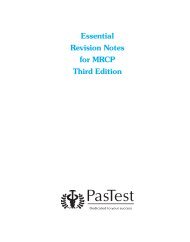MRCPCH 1: Essential Questions in Paediatrics - PasTest
MRCPCH 1: Essential Questions in Paediatrics - PasTest
MRCPCH 1: Essential Questions in Paediatrics - PasTest
- No tags were found...
Create successful ePaper yourself
Turn your PDF publications into a flip-book with our unique Google optimized e-Paper software.
CARDIOLOGY – ANSWERS 91.6 Eisenmenger syndrome: A B CEisenmenger syndrome was first described <strong>in</strong> 1897, and occurs secondaryto a large left-to-right shunt (usually a ventricular septal defect oratrioventricular septal defect) <strong>in</strong> which the pulmonary hypertension leadsto pulmonary vascular disease (<strong>in</strong>creased resistance over many years).Eventually, the flow through the defect is reversed (right-to-left) so thechild becomes blue, typically at 10–15 years of age. There is not usually asignificant heart murmur. Eventually, they develop right heart failure. TheECG shows right ventricular hypertrophy and stra<strong>in</strong> pattern, with peakedP waves <strong>in</strong>dicat<strong>in</strong>g right atrial hypertrophy. Management is largelysupportive, as surgical closure is not possible when there is a right-to-leftshunt. They may be commenced on sildenafil or an endothel<strong>in</strong>-receptorantagonist on the advice of a specialist <strong>in</strong> pulmonary hypertension.Best of Five Answers1.7 B: Tricuspid atresiaTricuspid atresia is the condition <strong>in</strong> which there is no tricuspid valve andusually the right ventricle is very small. There is right-to-left shunt at atriallevel, as the blood cannot pass <strong>in</strong>to the right ventricle. Babies become verycyanosed when the ductus arteriosus closes if they are duct-dependent,and they usually have no heart murmur. Management options <strong>in</strong>clude aBlalock–Taussig shunt if the child is very blue, a pulmonary artery (PA) bandif they are <strong>in</strong> heart failure, a hemi-Fontan procedure after they reach 6months of age, and a Fontan procedure at 3–5 years of age. The ECG showsa superior axis, as the atrioventricular junction is located <strong>in</strong>feriorly, the Pwaves are large as a result of right atrial hypertension, and there is a smallright ventricle, reduc<strong>in</strong>g the forces visible on the ECG.1.8 A: Asplenia and a midl<strong>in</strong>e liverRight atrial isomerism is a multifactorial genetic defect. Right atrialisomerism is associated with asplenia, small-bowel malrotation, andcomplex heart disease with abnormalities of connection, <strong>in</strong> which thepulmonary ve<strong>in</strong>s always connect abnormally because there is nomorphological left atrium with which to connect. In left atrial isomerism,there is polysplenia, small-bowel malrotation (less common than <strong>in</strong> rightatrial isomerism), two left lungs and complex heart disease.
















